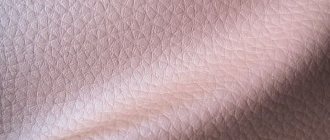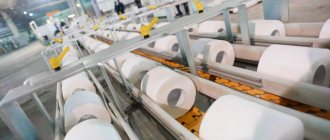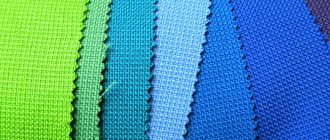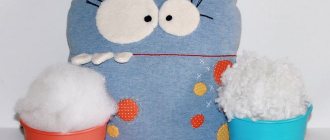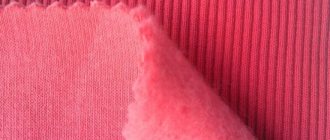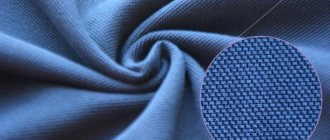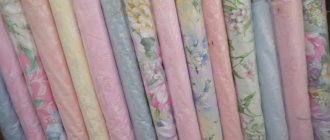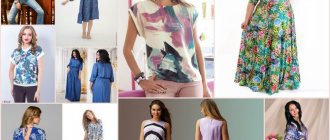Why are membrane fabrics needed?
Membrane fabrics: samples
The word “membrane” has ancient origins and means “membrane”. In ancient times it was used in everyday and biological senses. As science developed, the term acquired physical, chemical, and technical meaning. Now membrane technologies are used in light industry for the production of clothing.
One of the main functions of clothing is protective. Previously, rubber shoes, plastic raincoats, and capes made of other waterproof fabrics were used to protect against rain. These materials protected well from rain, snow, and wind for some period of time. It is impossible to stay in waterproof products made using old technologies for a long time.
On average, the human body releases more than half a liter of moisture per day, which accumulates on clothes from the inside if there is no way out. With active movements, the volume of sweat released can reach one and a half liters.
The introduction of membranes into the composition of protective fabrics allows water vapor to be removed while preventing moisture, wind, rain, and snow from getting inside.
What is membrane tissue
A material, one of the layers of which is a porous film that can pass water vapor in one direction and retard the penetration of liquid in the opposite direction, is called membrane fabric (MT). On 1 cm² of its surface there are more than 1 billion microscopic membranes, which determines the waterproof and breathable properties of the fabric. Clothing made from MT protects from rain and wind, but does not allow fumes to accumulate inside. The human body remains dry, so he feels comfortable in any weather.
History of creation
Since 1959, Wilbert Gore has been studying the properties of polytetrafluoroethylene (PTFE), a new polymer material at that time. Together with his wife, he organized a small company, WL Gore & Associates. Bill Gore was trying to find a use for PTFE, also known as Teflon. The experiments were continued by Wilbert's son, also a chemist by training.
Bob Gore managed to achieve results in 1969, when he applied rapid stretching to Teflon under certain conditions. From such exposure, PTFE turned into a film with a microporous structure, which had high vapor permeability and almost did not absorb water. Stretchable polytetrafluoroethylene is abbreviated ePTFE.
In 1970, the company patented the invention and began producing products based on Teflon film, which were used in the field of electronics and medicine. The development of WL Gore & Associates continued after receiving an order from NASA to produce fabric. The Gore-tex brand became the first manufacturer of membrane materials. Company developments until 1980:
- tape for sealing seams;
- 2-layer fabric;
- glove inserts.
Over time, WL Gore & Associates became a manufacturer of clothing and footwear made from different types of Gor-tex fabric - breathable, windproof and waterproof. Gore-Tex suits were worn by American astronauts and Antarctic explorers. After the patent obtained by U. Gore's company expired, other manufacturers also began producing MT.
Material composition
The main component of MT is Teflon or polyurethane film. This material cannot be used for sewing clothes on its own, as it is too thin and fragile. In addition, the porous surface quickly loses its one-sided waterproofness due to contamination and mechanical deformation. To prevent this, the membrane layer is connected by lamination or gluing to another fabric, which becomes protective for it.
The number of layers to which the membrane is connected is marked with numbers from 2, 3 or 2.5 next to the letters L/layer and is indicated in the description of the MT product. In 2-layer formulations, the porous film is glued or welded to the face fabric. The material turns out to be flexible and light, but short-lived: its underside is not protected in any way from mechanical damage and contamination from skin secretions.
Clothes made from such MT are equipped with a loosely attached lining made of mesh or soft textile, which is not entirely convenient: it can interfere with active movements. In 2.5-layer compositions, a special protective coating is applied to the reverse side of the membrane. This eliminates the need for lining, thereby reducing the weight of the finished garment.
3-layer MTs consist of a porous component placed between the outer and lining material. The method of applying Teflon film to face fabric is lamination. This type of membrane is the heaviest and least flexible, but is highly wear-resistant.
The weight, durability and other properties of MT are determined by the composition and density of the textile from which the protective layers are made. For the front side, artificial fibers are most often used: light and durable nylon or cheaper polyester. The inner layer is protected by mesh textile.
Main characteristics
Parameters that determine the properties of fabric with a membrane layer:
- Waterproof.
- Vapor permeability.
The first characteristic is determined by the height of the water column (in mm) that the material can withstand until water begins to seep through it. The higher this indicator, the better. Thus, the number 20,000 indicates that the MT will not allow water to pass through even under stormy conditions; 10000 – withstands rain or snowfall; 5000 – will not get wet under light precipitation.
The breathability of MT depends on the level of vapor permeability. They influence how comfortable a person will be in wearing clothes made from it. This characteristic is determined using two methods. Gore-Tex calculates RET (resistance to evaporation). The test samples are checked for the ability of the membrane to resist the passage of steam through it. The lower the RET value, the better the material breathes. The most breathable are MTs with RET from 1 to 6.
Other manufacturers use the value of the rate of water vapor transition through the membrane - MVTR. It is measured in g/m²/24h and shows how many grams of steam can pass through 1 m² of fabric being tested per day, i.e. the faster the fabric passes steam, the greater the vapor permeability. For the most breathable MT it is above 13000; materials with MVTR 6000-13000 have good breathability, and MVTR 3000-6000 have normal breathability.
Advantages and disadvantages
Materials with a membrane are used in light industry for sewing adult and children's travel clothing, equipment for winter sports, running, and cycling in any weather, but items made from them are not intended for everyday wear. A jacket made of MT will protect from rain and snow, and will keep you warm if you wear thermal underwear or 1-2 layers of additional insulation made of fleece or knitwear under it in winter. Advantages of things made from membrane:
- well protected from the wind;
- almost do not get dirty;
- are light in weight;
- durable;
- retain heat;
- equipped with reliable fittings.
MT outerwear is expensive, however, despite its strength, it cannot be considered durable.
This is explained by the fact that the pores are destroyed over time, and the water-repellent properties of the fabric gradually decrease. Things must be handled with care; they cannot be dry cleaned, and only certain types of membranes can be machine washed.
Structure and mechanism of action of membranes
The simplest example of a membrane product is a cellophane bag (not to be confused with a plastic bag). If, for example, you pour a salted protein solution into a plastic bag and hang it in a container with clean water, then after a while the salt will penetrate through the pores of the cellophane into the water. Cellophane selectively allows small molecules to pass out, retains large ones inside, and water molecules from outside do not leak into the bag.
Operating principle of membrane fabric
The membrane layer in tissues works in a similar way. It allows small molecules to come out without letting anything in.
Membranes used in light industry are usually divided into porous (containing pores) and non-porous (supposedly not containing pores). This division is arbitrary, but widespread. It is advisable to use it.
- Membranes with pores are thin polymer layers with very small holes through which molecules of gaseous water (steam) can leak from the inside, but drops cannot fit there. Let us remind you of the school course: in a drop, water molecules “stick together” - they are in the form of associated groups. In the vapor state, water molecules are lonely, the distance between them does not allow them to unite. The American company Gore-TeX makes membrane fabrics from Teflon, per 1 cm2 of which there are about one and a half billion microholes - pores.
- Non-porous membranes act differently. They also contain many microcells with complex, sinuous shapes that resemble the structure of a sponge. Steam from the skin is absorbed into the cells, saturates the membrane, turns into condensed moisture and, due to the difference in partial pressure (this concept is also from school courses), is released out. This principle of release is possible because there is more vapor inside than outside. If, hypothetically, the owner of the clothes wears them into a sauna or other room with very high humidity, moisture will enter in the same way.
In some materials, different membranes are combined, a layer without pores is placed on the outside, and a layer on the inside with pores. The fabric is effective, but expensive.
Classification of membrane tissues
Now almost all membranes are coated with an additional water-repellent layer of DWR, from which liquid simply rolls off. The eVENT variety has an oleophobic effect - its surface repels fats secreted by the human body, which greatly improves the breathability of the material.
By structure
The structure of MT is always cellular, but the location and size of the pores can be different. Based on the structure of the membrane layer, tissues are divided into porous and non-porous. The principle of operation of pore (hydrophobic and microporous) membranes is based on the fact that drops of water falling on them from the outside are much larger than the pore openings in size, and cannot get through them into the jacket or trousers. The size of the vapor molecules is such that they easily penetrate the membranes to the outside. Clothes made from porous fabric require careful handling, as they become dirty and deteriorate faster.
Poreless (monolithic or hydrophilic) MTs have a more complex structure compared to porous ones. It resembles a sponge in which the pores are located randomly throughout the entire volume of the material. Therefore, it is less contaminated, lasts longer, and can withstand a wider temperature range. Evaporation passes through the MT cells due to the difference between the air pressure that is inside and outside the item sewn from it. The expulsion of water vapor from the membranes occurs only after the pressure in them exceeds atmospheric pressure.
The most expensive option for MT is combined. It is produced by applying a non-porous layer to the front side of the pore tissue. Such materials have high rates of water and vapor permeability, and clothing made from them is the most comfortable.
By purpose
There is no strict classification of MT by area of use, but two groups of materials that perform different functions can be distinguished. Windproof MTs are obtained by applying a porous layer to thin fleece. Most often they are equipped with water-repellent impregnation, which allows them to withstand drizzling rain. They are used by cyclists as demi-season clothing, because gloves, cycling pants and windbreakers made from such materials are light in weight, dry quickly and retain heat.
Waterproof membranes are designed for sewing equipment worn during heavy rain or snow. They are also used to make shoes and various accessories that do not get wet, but allow protected areas of the body to breathe.
Comparison of terms of use
- All membrane tissues remove vapors from an area of high pressure to a zone of low pressure (as experts in the value gradient say).
- At high humidity, membranes with pores remove vapors better, especially if there is ventilation on the clothes. Poreless membranes are effective in relatively dry air environments. If the humidity is high or the ventilation is open, such a membrane will not work well.
- At low temperatures, a membrane with pores works better. At subzero material temperatures, poreless membranes simply freeze.
- The porous membrane can become clogged if not properly cared for or worn. Poreless membrane fabrics are durable and last a long time.
Main characteristics
Membrane fabrics are designed to protect against bad weather and create a sense of comfort for wearers. Functions justify the importance of key indicators.
- Waterproof. At high pressures in the water column, any fabric will begin to leak. Maximum tolerable exposure values are important for successful operation. Clothing intended for harsh conditions must withstand pressures of 20,000 mm water column and above. A value of 10,000 mm is acceptable for normal rainy weather conditions.
- Vapor permeability characterizes the mass of vapor in grams that 1 m2 of material can release in a given unit of time (usually 24 hours). The often found minimum vapor permeability is 3000 g/m2, the maximum is from 10,000 g/m2. This property is sometimes assessed by its ability to resist steam transport (RET). If this indicator is 0, the fabric completely transmits all steam; with a value of 30, the passage of steam is practically eliminated.
The membrane does not perform insulating functions. It protects from rain, wind, snow, provides “breathing” to the body, and helps provide thermal comfort.
What do membrane characteristics mean?
What is a membrane?
MEMBRANE is a thin-layer coating of the inner surface of the fabric. The membrane provides a favorable climate inside the clothing, and microscopic pores allow water vapor to escape while blocking the penetration of moisture from the outside.
Membrane fabric consists of two layers: the top fabric ( can be absolutely any, both thin and dense ) and, directly, the membrane - the thinnest polymer film with specially shaped pores that ensure one-sided water permeability (moisture on the inside migrates freely through membrane, while moisture located outside is retained by the membrane).
How does it work?
External moisture does not penetrate inside, excess heat and water vapor (our sweat) escapes from the inside through the fabric, which improves body thermoregulation.
What do the numbers and characteristics mean?
Any membrane clothing has two characteristics on the label, usually separated by a slash, like 5000/10000 or 5000mm/10000g. The first parameter is water. The second parameter is air.
1. The water resistance of a fabric is measured by the height of the water column that it can withstand without getting wet. Unit of measurement mm.
2. Vapor permeability (Air permeability) characterizes how much moisture in the form of steam passes out of one meter of fabric in 24 hours. Unit of measurement g/m2/24 hours. The higher the value of these parameters, the better.
* For comparison: the maximum water resistance of cotton is 500 mm, synthetics without special treatment is 1000 mm. At the same time, the vapor permeability required for active sports, for example, alpine skiing, is 10,000 g/m2/24h, and for walking - 3000 g/m2/24h.
BREATHABLE – membrane fabric for non-extreme conditions. Used in Caimano products. Water resistance 2000 - 5000 mm. Air permeability 2000-5000 g/m2/24 hours.
Types of Features Used in Color Kids Clothing
Air-Flo 10000: Waterproof, windproof and breathable.
Maximum protection in the harshest weather conditions. Finish: Laminated membrane Water repellency: + 10,000 mm Windproof: yes Vapor permeability: + 5000 g/m/24 h Seams: fully taped (FTS)
Air-Flo 5000: Waterproof, windproof and breathable
Superior protection in all weather conditions. Material: AF 5000 PU coating / laminated membrane Water repellency: + 5,000 mm Windproof: Yes Vapor permeability: +5000 g/m/24 h Seam taping: Full seam taping (FTS)
Air-Flo 3000: Waterproof, windproof and breathable
100% protection in all weather conditions Material: AF 3000 PU coating Water repellency: + 3,000 mm Windproof: Yes Vapor permeability: +2000 g/m/24 h Seam taping: Partial seam taping (PTS)
Air-Flo 2000: Waterproof, windproof and breathable
Effective protection in all weather conditions. Material: Coating AF 2000 PU Water repellency: + 2,000 mm Windproof: Yes Vapor permeability: Yes Seam taping: No
Fabric structure
Structurally, membrane fabrics differ in design.
- In two-layer fabrics, the membrane is fixed on the inside of the fabric. Additionally, it is covered with a lining that protects it from damage and clogging.
- In three-layer fabrics, the outer layer, membrane, and inner mesh are glued together. There is no need for a lining layer. The material is very comfortable, it costs more.
- In some modifications, a special protective coating is sprayed onto the inner surface of the two-layer fabric.
- There are types of membrane fabrics with a water-repellent layer (DWR) applied on top. The coating may wash off over time. It is easily restored using special means.
Description of fabric Membrane
The membrane is a synthetic material. It has the following properties:
- Waterproof. This indicator is presented in digital form. Indicates the water pressure that matter can withstand. When purchasing membrane-based products, this criterion must be taken into account. If the product has the number 3,000, this indicates that the material is able to resist light rain. But material with an index of 10,000 is not afraid of heavy rain. Material with 20,000 is a product that will not get wet even in severe bad weather and stormy conditions.
- Vapor release . This criterion is also presented in number format. Displays the amount of steam in g/m2 of fabric that comes out per day. The higher this criterion, the better the material.
- Wind protection. With membrane-based products, you don’t have to worry about getting chilled by strong winds.
Types and characteristics of membrane material
Membrane fabric today comes in various types. If we consider fabric by fabric design, we distinguish the following types:
- Double layer. Their production is carried out using a special technology. Its essence is that a membrane is attached to the inner side of ordinary matter. On top it contains protection in the form of a lining.
Double layer fabric membrane - Three-layer. They are presented in the form of a base, the membrane fabric itself and a knitted mesh. All these layers are fastened together using the lamination method. The mesh acts as a lining here. Thanks to this production technology, it is possible to reduce the weight of finished clothing.
- Double layer with jersey lining. In its design, this version of the material is very similar to the three-layer one.
Three-layer fabric membrane
A distinctive feature is that instead of a lining there is foam knitwear. Such membrane clothing has even less weight, but this does not affect its properties in any way.
The video shows a description of the membrane fabric:
Leading manufacturers
Membrane fabric in clothing
The most authoritative, historically the first company producing membrane fabrics is Gore-TeX. She made clothes for astronauts. Then several types of products were offered to skiers, climbers, and mountain tourists.
Clothing with Triple-Point, Sympatex, ULTREX membranes is comparable in quality. The material is good quality and is available in several modifications. The price is high, consistent with the properties of the products.
Products with Ceplex and Fine-Tex membranes have an affordable price. It is designed for a maximum of 2 seasons of active wear, after which the material may begin to leak a little water.
When buying clothes made from membrane fabrics, pay attention to the information about taping seams. In some varieties, absolutely all seams are taped, in others - only the main ones. For wearing in the city, taping the main seams is enough. For active sports, it may be better to choose products with all reinforced seams. The choice is up to the potential owner of the clothing.
Rules for caring for membrane tissues
The material is specific in composition and structure. Conventional washing techniques should not be applied to this group of products.
- You can wash fabric with a membrane layer in a machine using a gentle cycle and mild special products.
- You can't do push-ups in the car.
- Cannot be dry cleaned.
- There is no need to iron, there is no need to do this.
- Can be washed by hand if desired.
- You can leave the item in an arbitrarily straightened state so that water drains from it.
- The fabric gets dirty very little. After wearing and drying, it can be lightly cleaned with a regular brush.
Fabrics with membrane materials allow you to feel protected in any bad weather during the most active activities.

